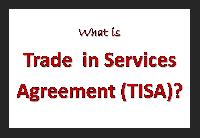
On services trade, the WTO has the well-known General Agreement on Trade in Services (GATS) Agreement. It is the international code of conduct that provides the rules for promoting international trade in services. But several countries especially that those who are members of notable Free Trade Agreements are not happy about the limited trade liberalization envisaged by the GATS. They are designing higher order service trade liberalistion. One such trade arrangement which is under formation level is the Trade in Services Agreement.
What is Trade in Services Agreement (TISA)?
Trade in Services Agreement is a plurilateral services trade liberalization attempt among selected WTO member countries aiming to liberalize services trade beyond what WTO permits. The TISA discussions are undergoing between 23 participants dominated by developed countries including the US, and the EU, Switzerland and developing countries including Mexico, Peru, Pakistan etc.
TISA was launched in 2013 and is aimed to open up the markets of the participating countries by liberalizing trade rules in major service areas including ecommerce, financial services, maritime transport, licensing and movement of professions to do job in partner countries. According to the TISA negotiating framework, the forum is open to all WTO members and they can join during discussions and after ratifying the agreement.
TISA negotiating countries
TISA has notable presence of both developed and developing countries. Besides the 28 EU countries, the TISA negotiators include: Australia, Canada, Chile, Chinese Taipei, Colombia, Costa Rica, Hong Kong, Iceland, Israel, Japan, Korea, Liechtenstein, Mauritius, Mexico, New Zealand, Norway, Pakistan, Panama, Peru, Switzerland, Turkey and the the United States.
Why TISA?
There is strong belief especially among the developed world that the WTO is not able to launch higher order trade liberalization steps. They believe that WTO members have heterogenous interests and consensus are difficult to occur. So, the developed countries have formed several higher order free trade agreements by including provisions like TRIPs Plus. The TRIPs Plus features contains advanced intellectual property protection beyond what the WTO instructs. In this context, the TISA brings more punch to service trade liberalization.
Additionally, services constitute to nearly 70% of GDP in developed countries but its share in world trade is just around 30%. So, there is greater scope for service trade liberalization and time has reached for getting into more liberalization in services trade. TISA negotiating countries account for nearly 70% of world trade in services.
TISA issues and negotiations
The TISA architecture is based on the WTO’s General Agreement on Trade in Services (GATS) and provisions under negotiations are compatible with GATS. At the same time, the negotiations cover important emerging areas like ecommerce and movement of natural persons (Mode 4 under GATS). As negotiations are going on, the nature of TISA liberalization is yet to be assessed.
Why TISA is important for India?
India considers services trade liberalization important because the country has advantage in services trade. India is one of the top ten service exporting countries in the world. Within WTO, India argued for more service trade liberalization including removal of visa restrictions by the developed countries on movement of natural persons. India has a progressive agenda for service trade liberalization with key interests in further liberalisation of cross-border service delivery (Mode 1) and movement of natural persons (Mode 4). Hence, India has tremendous interest in any service trade negotiations including the TISA.
At the same time, India is opposed to some of the provisions of TISA under negotiation. According to unofficial information available from the Commerce Ministry, India has disagreement with three contentious clauses—standstill, ratchet and MFN. These clauses of detrimental to the interest of the country as it doesn’t give a member country to retrieve from a current liberalization position. The ‘Standstill’ instructs a member to retain current level of domestic liberalization in services and the member can’t reverse in future. ‘Ratchet’ requires commitment for future policy changes by the member country. The MFN clause instructs that any future concession given to a trading partner under a bilateral treaty will automatically get extended to other members of Tisa (including Pakistan).
Mode 4 liberalization under TISA
A major feature of TISA is that it proclaims a much more movement of natural persons provision through discussions are going on. This means technical persons like engineers, lawyers, doctors etc., can get employed in the partner country under temporary work contract. Here, the movement is for trade-related mobility but not labour migration.
Current status of TISA
Negotiations on TISA is on a slower mode in the context of the general global slow-down on free trade engagements.
India is already holding discussions with European Union for a Free Trade Agreement and the country hope to reach a bilateral consensus rather than going for a multilateral platform so that multiple trade and non-trade issues related with such engagements can be avoided. Involvement of Pakistan in TISA poses operational difficulty even if India is going to become a member.
*********









